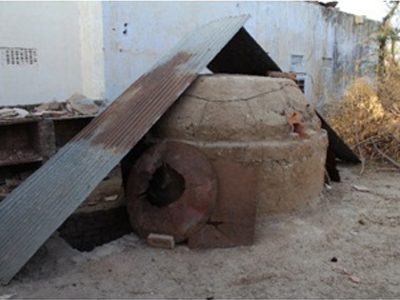Home / Infrastructural Development / Infrastructural Aid to Blue Pottery Artisans-Reducing artisan drudgery , improving work & process efficiencies
One of the major objective of SETU’s work spectrum is to help artisans improve their working conditions & work processes. The main motive is also to reduce human drudgery, & improve process efficiencies. There is also a need to optimize raw material & fuel consumptions & improve quality. These parameters are important to achieve all 3 aspects of sustainability, viz economic, environmental & human/social.
SETU has been working with blue pottery artisans, based near Jaipur (Rajasthan) since past three years.
SETU is always hesitant in encouraging any craft form that may be hazardous to artisans or the end consumers. Raw materials used in normal blue pottery may contain lead & inhaling the leaded fumes during the production process may be hazardous to artisan health. When our team met the artisans 3 years back, they could not make lead free products. So the first task for us was to help them develop lead free Blue pottery, before starting any new product development with them. The whole process took us almost 1 year of hard work, but finally the artisans were able to produce lead-free pottery.. 🙂 Our first milestone here!!
As we started working with the artisan group, more issues related to process & infrastructure came to light. The group had been facing numerous problems while manufacturing the products, which made their products non-competitive & more expensive in the market. Some of them were :
• excessive breakage of the artefacts during curing
• Black spots leading to rejections
• Excessive consumption of LPG
• The furnace space not being fully utilized.
• Incapability in producing objects of larger dimensions.
• Desired quality not being achieved during curing of products.
After discussions & brainstorming with the artisans, it was found that by using good quality, large sized refractory grade tiles & stands for arranging the raw pottery in the furnace, a no. of problems could be solved. The refractory brick tiles, especially in larger sizes, were quite expensive & the artisan group expressed their inability to afford the same. And so, SETU sponsored these refractory stands & tiles & these were finally found to be very useful to the artisans.
Following positive changes have been observed after the use of new refractory tiles:
• The level of breakage and black spots in the material have reduced by 80% due to refractory grade & larger tiles. This allows uniform heating inside the furnace.
• The new tile size is 17″x21x20″ against original small tiles of size 8x10x13″.
• Due to above, they can now make large sized products up to 12″ dia, as against 8″ dia limitations earlier.
• Earlier, they had to set 12 rows in the furnace, but now due to large tiles, only 4 rows are sufficient. This reduces man power drudgery & a saving of 4 man-hours per furnace loading.
• The furnace capacity is now fully & evenly utilized.
• For every cycle, the consumption of LPG has reduced by at least one cylinder.
• Since the heating is more even, & the level of products is more balanced, the overall lustre & quality of pottery has improved.
Artisans of the group are very happy with the support provided by SETU as now they can work with ease and make better quality produce that too in a shorter duration of time, with less rejections & breakages.
Images of the workplace before the use of refractory tiles:
After the use of refractory tiles..
